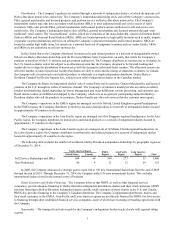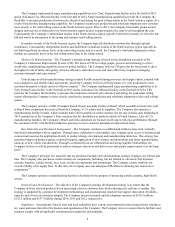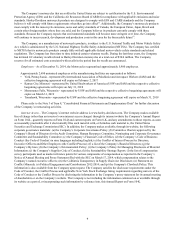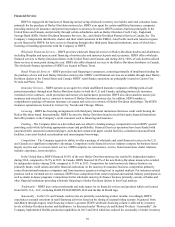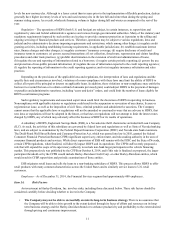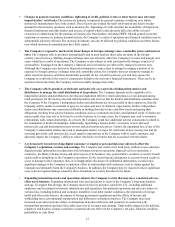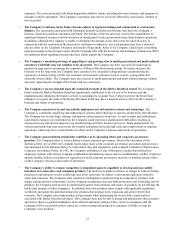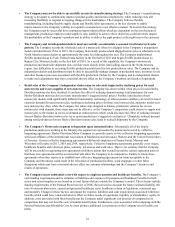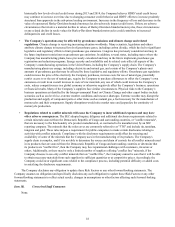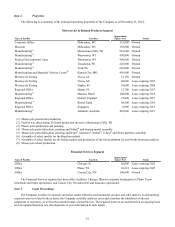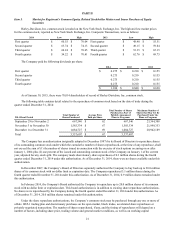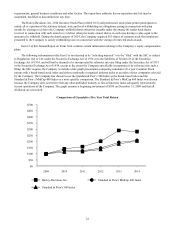Harley Davidson 2014 Annual Report Download - page 17
Download and view the complete annual report
Please find page 17 of the 2014 Harley Davidson annual report below. You can navigate through the pages in the report by either clicking on the pages listed below, or by using the keyword search tool below to find specific information within the annual report.
•The ability of the Company to expand international sales may be impacted by existing or new laws and
regulations that impose motorcycle licensing restrictions and limit access to roads and highways.€Expanding
international sales is a part of the Company’s long-term business strategy.€A number of countries have tiered
motorcycle licensing requirements that limit the ability of new and younger riders to obtain licenses to operate the
Company’s motorcycles, and many countries are considering the implementation of such requirements.€These
requirements only allow new and/or younger riders to operate smaller motorcycles for certain periods of time.€Riders
typically are only permitted to obtain a license to ride larger motorcycles upon reaching certain ages and/or having
been licensed to ride smaller motorcycles for a certain period of time, and only after passing additional tests and
paying additional fees.€These requirements pose obstacles to large displacement motorcycle ownership.€Other
countries have laws and regulations that prohibit motorcycles from being operated on certain roads and
highways.€These types of laws and regulations could adversely impact the Company’s plans to expand international
sales.
• The Company has a number of competitors, some of which have greater financial resources than the Company.
Many of the Company’s competitors are more diversified than the Company, and they may compete in all segments of
the motorcycle market, other powersports markets and/or the automotive market. Also, the Company’s manufacturer’s
suggested retail price for its motorcycles is generally higher than its competitors, and if price becomes a more
important competitive factor for consumers in the markets in which the Company competes, the Company may be at a
competitive disadvantage. In addition, the Company’s financial services operations face competition from various
banks, insurance companies and other financial institutions that may have access to additional sources of capital at
more competitive rates and terms, particularly for borrowers in higher credit tiers. The Company's responses to these
competitive pressures, or its failure to adequately address and respond to these competitive pressures, may have a
material adverse effect on the Company’s business and results of operations.
• The Company’s operations are dependent upon attracting and retaining skilled employees, including skilled
labor, executive officers and other senior leaders. The Company’s future success depends on its continuing
ability to identify, hire, develop, motivate, retain and promote skilled personnel for all areas of its organization.
The Company’s current and future total compensation arrangements, which include benefits and incentive awards,
may not be successful in attracting new employees and retaining and motivating the Company’s existing employees. In
addition, the Company must cultivate and sustain a work environment where employees are engaged and energized in
their jobs to maximize their performance. If the Company does not succeed in attracting new personnel, retaining
existing personnel, implementing effective succession plans and motivating and engaging personnel, including
executive officers, the Company may be unable to develop and distribute products and services and effectively execute
its plans and strategies.
•The Company’s Financial Services operations rely on external sources to finance a significant portion of its
operations. Liquidity is essential to the Company’s Financial Services business. Disruptions in financial markets may
cause lenders and institutional investors to reduce or cease to loan money to borrowers, including financial
institutions. The Company’s Financial Services operations may be negatively affected by difficulty in raising capital in
the long-term and short-term capital markets. These negative consequences may in turn adversely affect the
Company’s business and results of operations in various ways, including through higher costs of capital, reduced funds
available through its financial services operations to provide loans to independent dealers and their retail customers,
and dilution to existing share value through the use of alternative sources of capital.
•The Company’s Financial Services operations are highly dependent on accessing capital markets to fund their
operations at competitive interest rates, the Company’s access to capital and its cost of capital are highly
dependent upon its credit ratings, and any negative credit rating actions will adversely affect its earnings and
results of operations. The ability of the Company and its Financial Services operations to access unsecured capital
markets is influenced by their short-term and long-term credit ratings. If the Company’s credit ratings are downgraded
or its ratings outlook is negatively changed, the Company’s cost of borrowing could increase, resulting in reduced
earnings and interest margins, or the Company’s access to capital may be disrupted or impaired.
•The Company’s Financial Services operations are exposed to credit risk on its retail and wholesale receivables.
Credit risk is the risk of loss arising from a failure by a customer, including the Company's independent dealers and
distributors, to meet the terms of any contract with the Company’s financial services operations. Credit losses are
influenced by general business and economic conditions, including unemployment rates, bankruptcy filings and other
factors that negatively affect household incomes, as well as contract terms, customer credit profiles and the new and
used motorcycle market. Negative changes in general business, economic or market factors may have an additional
adverse impact on the Company’s financial services credit losses and future earnings. While HDFS experienced
17


